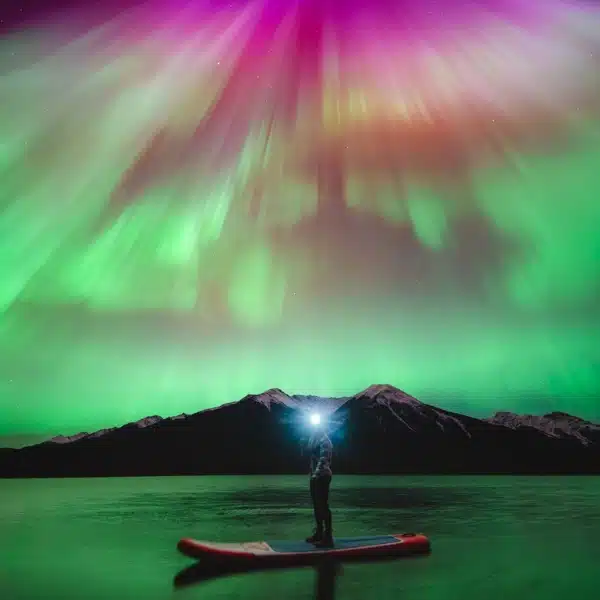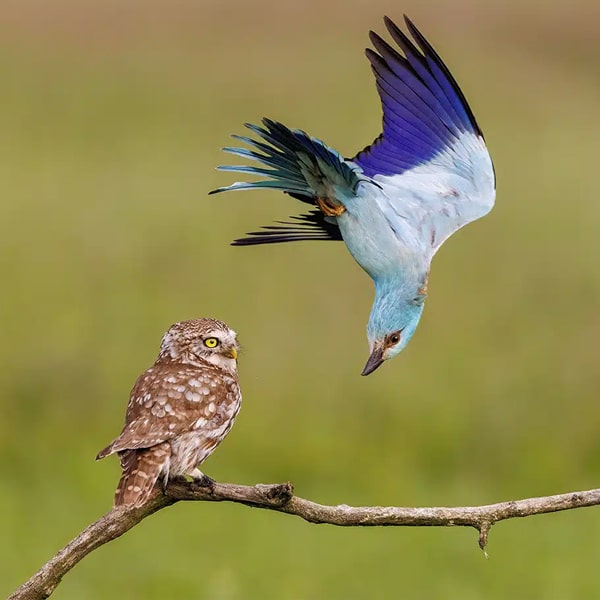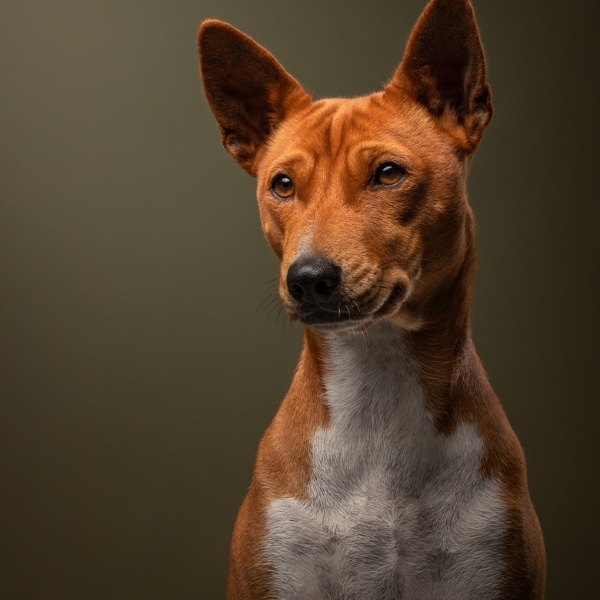
“End of the Day” by Majed AlZa’abi (Kuwait). European Shag Gulosus aristotelis. Vardø, Norway.
Grand Prize, Bird Photographer of the Year. Winner, Best Portrait.
“I took this shot in April 2019 while on a visit to the famous Norwegian seabird island of Vardø, a location packed full of birds that provide endless opportunities for photography. It was my first visit to the island, one that was prompted by hearing about its birdlife. Despite being forewarned, I was really amazed by what I saw: hundreds of birds flying all the time, all day during the five days we visited. It was my plan to stay with a particular subject over an entire day: one day with Atlantic Puffins, another day with European Shags and so on. Also, there are a lot of opportunities for creative composition, playing with foreground and background; here I like the out-of-focus shag framing the in-focus individual, plus the bokeh of the sea as sunset approached. By experimenting, I aimed to create artistic and impressionistic shots of shags, and I hope I achieved my goal with this image.”
For the fifth year, conservation charity Birds on the Brink has hosted the Bird Photographer of the Year competition. Wildlife photographers from around the world submitted their best images of our feathered friends across several different categories. In the end, Kuwaiti photographer Majed AlZa’abi took home the top prize and was awarded £5,000.
AlZa'abi nabbed the win for his artistic portrait of European shags on the Norwegian island of Vardø. This bird lovers paradise is filled with large colonies of seabirds, which attracts bird watchers and photographers from around the globe. AlZa'abi's eye for the subject and the unique manner in which he captured the spirits of the birds made this image stand apart from the 15,000 entered in the contest.
“To win this competition it takes a very special photograph,” declared the judging panel. “Technical perfection is simply not enough; it is the imaginative eye and a mind that seeks out the unusual and the artistic in the every day that will do well. The vast majority of the 15,000 images entered annually are of an amazing standard, sufficient eye-candy to feed even the most visually gluttonous. But create a photograph that makes us sick with envy or cry out with uncontained excitement, then you are in with a chance. When that collective shout from the judges is ‘I wish I had taken that myself’, then you are onto a winner. Well done Majed for sharing this stunning image with us—it is a well-deserved winner.”
In addition to AlZa'abi's photograph, there are many standout portraits from the eight contest categories, which range from Birds in Flight to Creative Imagery. Whether looking at the stunning details of a bird's anatomy or being inspired by its behavior, these photographers have dedicated their craft to highlight the wonders of the avian world.
All of the winning images will be published in the Bird Photographer of the Year book, which features over 200 photographs from the 2020 contest.
The winners of the 2020 Bird Photographer of the Year contest highlight the wonders of the avian world.

“Pacific Gull Blur” by Georgina Steytler (Australia). Pacific Gull Larus pacificus. Jurien Bay, Western Australia, Australia.
Winner, Best Portfolio.
“The sun had set in a coastal town of Western Australia when I saw this Pacific Gull bathing in the waves. I used a slow shutter speed as it was quite dark, and experimented. This is a shot of the bird after it emerged from the water and flapped its wings to remove the excess.”

“Rainbow of the Forest” by Mathias Putze (Germany). Ocellated Turkey Meleagris ocellata. Tikal, El Péten, Guatemala.
Runner-Up, Attention to Detail.
“It was never my plan to take a picture like this. Just seeing this extraordinary bird was as much as I expected. Luckily, however, the combination of thousands of visitors to the Mayan remains, and the prohibition of any hunting inside Tikal National Park mean wildlife is quite relaxed. I was more than surprised to find an adult male Ocellated Turkey preening at the forest edge not far from the trail. What a treat. Elsewhere in Central America the species is often persecuted, and either rare, or wary of people, or both.”

“Hoopoe Flight at Low Speed” by Gadi Shmila, (Israel). Common Hoopoe Upupa epops. Israel.
Winner, Birds in Flight.
“I had this image in my head long before it was created. Once I found the exact location for the image, I began several attempts until I found the balance between blur and freeze. To get the right ‘smudge’ you need very weak lighting, combined with a low shutter speed (1/8 second). By contrast, ‘freezing’ action requires a very high shutter speed or alternatively the use of flash. In this photo, I froze the action with the help of four flashes that were triggered at the end of the exposure. In my many different attempts, I felt the blur was not sufficiently bold, so to emphasize it I placed a black background behind the subject.”

“Swifts Over Iguazú Falls” by Francesco Filippo Pellegrini (Italy). Great Dusky Swift Cypseloides senex. Iguazú Falls, Misiones, Argentina.
Winner, Birds in the Environment.
“A few years ago I had a chance to visit the world-famous Iguazú Falls with my wife. Even though I had been told it was an amazing place, I nevertheless felt overwhelmed by the beauty of the valley: I was not prepared at all for the spectacle. Waterfalls are amazing places for photography, with a variety of wildlife sometimes framed by rainbows caused by the mist of the cascades. In Iguazú’s unique environment, the ‘swifts of the falls’ find the perfect shelter for breeding. While I was staring at a feature called the Devil’s Throat, I saw flocks of these birds flying all around. Due to the mist caused by the falls, I struggled taking this shot as I had to keep the front of the lens free of water drops.”

“Great Grey Owl” by Daniel Stenberg (Sweden). Great Grey Owl Strix nebulosa. Nynäshamn, Stockholm, Sweden.
Runner-Up, Black and White.
“As a photographer, sometimes you are just lucky. Most of the time you drive around you find nothing, but on this occasion I came across a Great Grey Owl using a post beside the road as a lookout. After taking the usual portrait shots, here I focused on composition in order to create a more graphic depiction of the bird. I felt the shot worked best in black and white.”

“Perfect Camouflage” by Moshe Cohen (Israel). Eurasian Scops-owl Otus scops. Kibbutz Hatzor, Israel.
Winner, Attention to Detail.
“This owl lives very close to my home—I know this because I hear its sonar-ping call in the night. However, finding and seeing the bird is a different matter as the species is notoriously difficult to spot, being adept at blending in with its surroundings. The plumage is a superb match for tree bark and it puts this camouflage to good use by roosting in appropriate settings. On this occasion I found the bird during the daytime, but it is still hard to see where owl ends and bark begins.”

“Nutcrackers Fighting in the Snow” by Roelof Molenaar (The Netherlands).
Northern Nutcracker Nucifraga caryocatactes. Sofia, Bulgaria.
Winner, Bird Behaviour.
“Northern Nutcrackers are intelligent and rather sociable birds, and I took this photograph on a ski piste in Sofia, Bulgaria. Due to the large number of birds in the area, fights broke out on a regular basis. In this image, I made use of the snow. The dark background emphasizes the snow and the backlit wings of the birds.”

“Cormorant Underwater View” by Greg Lecoeur (France). Brandt’s Cormorant Urile penicillatus. La Paz, Baja California, Mexico.
Runner-Up, Best Portrait.
“Like others of its kind, Brandt’s Cormorant is an adept swimmer whose diving skills come into their own when the bird is pursuing prey (mainly fish) underwater. This particular individual was swimming underwater in the hope of catching sardines. To achieve this portrait, rather than chase the bird I tried to blend into the scenery, as much as a diver ever can, and waited for the cormorant to swim by, framed by the fish it was trying to catch.”

“Seeing Double” by Adam Lake, age 17 (United Kingdom). Mute Swan Cygnus olor. Devon, United Kingdom.
Winner, Young Bird Photographer of the Year, 14-17 Years.
“I saw this juvenile Mute Swan while volunteering at a local canal. I stood and observed the swan, which seemed to make it curious. As I was volunteering, I didn't have my camera to hand, so I grabbed my phone and lay down on the tow path. This interested the swan, which slowly swam towards me cocking its head to the side. I took this photo from my low position on the tow path. My position enabled me to capture the mirror-like image and the surrounding scenery.”

“The Old Ship” by Kiko Arcas (Spain). Black-legged Kittiwake Rissa tridactyla. Båtsfjord, Norway.
Runner-Up, Garden and Urban Birds.
“In the coastal town of Båtsfjord in northern Norway there is a small colony of Black-legged Kittiwakes that breed in the most unlikely of places—an old ship. Our guide, Øyvlind, took us in a Zodiac to a ‘graveyard’ of large fishing boats where a large colony of kittiwakes had made that place their home. There were numerous nests, on occupied windows, old anchors, tires, and all manner of human artifacts. It was an incredible place and one that I hope to return to.”

“Photobombing a Game” by Magdaléna Straková (Czech Republic). House Crow Corvus splendens. Colombo, Sri Lanka.
Winner, Garden and Urban Birds.
“I was staying in an apartment in a high-rise building in Colombo and noticed this street basketball court under my balcony. I waited for a group of locals to come there in the evening and after I finally saw someone playing, I got out on the balcony. I leaned towards the railings to start shooting with my long lens pointing downwards and immediately regretted the idea—the metal railing was still blisteringly hot from the sun! Carefully balancing over the railings (20 floors up!) so as not to burn myself again, I took several series of shots. But I felt something was still missing… When I noticed the crow flying by, I quickly shot a couple more frames. I immediately knew that this was the element I had been waiting for to ‘complete’ my picture!”

“Mandarin Abstract” by James Hudson (United Kingdom). Mandarin Duck Aix galericulata. South Yorkshire, United Kingdom.
Winner, Creative Imagery.
“The Mandarin drake has arguably the most flamboyant plumage of any bird living in the UK. In Sheffield there are several places where Mandarins can be found living alongside people. In some cases, these wild ducks see humans more as a supplier of free food than a threat. As a result, I was able to get close enough to this individual to experiment with long-exposure photography and intentional camera-movement techniques. I wanted to create abstract images that captured the vibrancy of the duck's feathers as well as the excitement I feel when I see these extraordinary birds.”

“Single Room Available” by Robert Sommer (Germany). Common Starling Sturnus vulgaris. The Netherlands.
Winner, Black and White.
“One day, I spent the period around sunrise photographing a windmill in the northern Netherlands. From nowhere, I noticed twittering calls, which became louder and louder, and it turned out that Common Starlings were producing the sound. By the end of the shoot, the upper part of the windmill was full of starlings, so I went to my car to get a longer lens and tried to capture the abstract scene. Because of the strongly geometric form, I decided that the image worked better in black and white than it did with its original color.”

“Back-Lighting” by Ismael DomÌnguez Gutièrrez, age 11, (Spain). Crested Tit Lophophanes cristatus. Grazalema, Andalusia, Spain.
Winner, Young Bird Photographer of the Year 9-13 Years.
“This Crested Tit is perched on a twig, preparing to take a bath. The image was taken in the late afternoon as the sun's rays added a warmth to the colors. By back-lighting the subject I was able to enhance the effect.”

Homecoming” by Gail Bisson (Canada). Providence Petrel Pterodroma solandri. Lord Howe Island, Australia.
Winner, Inspirational Encounters Award.
“Years before I became interested in bird photography, I read The Fatal Shore, a book about the colonization of Australia and its brutal history of convict transportation. In the book, author Robert Hughes discusses the colonization of Norfolk Island and details the sad fate of its Providence Petrels. The heartbreaking story remained in my mind and heart for years, and I long harbored a wish to someday see a Providence Petrel. A recent trip to Australia allowed me to include a side trip to Lord Howe Island and have my dream realized.
The petrels were called Providence Petrels because they provided the only food available to the transported convicts from England when they landed on Norfolk Island in the late 1700s. The petrels were exterminated on Norfolk Island between 1790 and 1800. One million adults and young were harvested for food from 1790 to 1793, and numbers had dropped to 15,000 by 1796, with complete extermination by 1800. Today, other than a few pairs found nesting on Norfolk Island, and more recently a few pairs on Phillip Island, 99.9 per cent of the world population of Providence Petrels nest on Mt Gower on Lord Howe Island (roughly 32,000 pairs). The species is classed as Vulnerable. Its name is both ironic and heartbreaking, because the presence of humans was hardly ‘providential’ for these petrels. This past winter, Lord Howe Island started a rat-extermination program. By eliminating the rats it is hoped that petrel numbers will rise to a new high. What a wonderful moment it was to watch the petrels returning at dusk to Mt Gower.”

“Asian Green Bee-Eater Pair” by Deeksha Diya Sambath, age 7, (India). Asian Green Bee-eater Merops orientalis. Chennai, India.
Winner, Young Bird Photographer of the Year, 0-8 Years.
“My dad is a bird photographer and has been my inspiration; I love to accompany him on his weekend photography outings. This pair of Asian Green Bee-eaters are regular visitors to our backyard. I just love the color of these birds and how they catch the bees in mid-air. I took this photograph from the car with my dad’s camera.”

“Phalarope Reflections” by Terje Kolaas (Norway). Red-necked Phalarope Phalaropus lobatus. Utqiagvik, Alaska, United States of America.
Runner, Up, Creative Imagery.
“A few Red-necked Phalaropes were gathered on a small pond and a hill created a dark background, making the location perfect for backlight photography. The low midnight sun of Alaska made it possible to photograph through the ‘night’, and this is one of thousands of shots from the particular session. The low-angle backlight, taken through a big telephoto lens, creates the reflections.”

“Hawk Owl in a Mountain Forest” by Pâl Hermansen (Norway). Northern Hawk-owl Surnia ulula. Golsfjell mountain region, Norway.
Runner-Up, Birds in the Environment.
“This Northern Hawk-owl spent several hours in the top of the tree, looking over the winter landscape for food. As I realized the bird was very bold and fearless, I carefully launched my drone and approached it very slowly. The owl did not react, and allowed the drone to hover reasonably close. After finishing the photography, I backed off with the drone, leaving the bird perched for a further hour before it moved to another tree top.”

“Touch and Go” by Nikos Fokas (Greece). Pallid Swift Apus pallidus. Athens, Attica, Greece.
Runner-Up, Birds in Flight.
“Pallid Swifts are breeding visitors to Greece, and during the summer months they perform spectacular dives into this small pool of water. They appear one after the other, as if they are competing to see which one will do the best dive or else the best surface-skim. This particular one won that year’s competition by performing a high-speed open-winged dive with a splash, catching floating insects while keeping eye contact with the camera. I would award it ten out of ten for style and performance.”





















































































